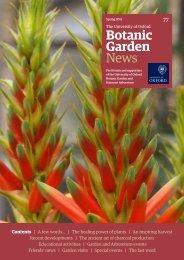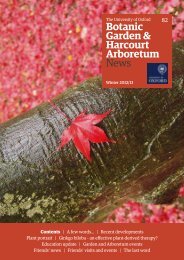Autumn/Winter 2011/12 - Harcourt Arboretum - University of Oxford
Autumn/Winter 2011/12 - Harcourt Arboretum - University of Oxford
Autumn/Winter 2011/12 - Harcourt Arboretum - University of Oxford
You also want an ePaper? Increase the reach of your titles
YUMPU automatically turns print PDFs into web optimized ePapers that Google loves.
Botanic Garden News | No. 79<br />
3<br />
into the UK unintentionally with plants<br />
before the 1920s. The tiny 2mm-long weevil<br />
Stenopelmus rufinasus has been here for<br />
decades and yet has found no other plants<br />
palatable. It is therefore now acceptable to<br />
release large numbers <strong>of</strong> the weevil even<br />
on Sites <strong>of</strong> Special Scientific Interest (SSSI).<br />
Using one introduced organism to control<br />
another is a risky business but in this case it<br />
seems to be safe.<br />
Azolla is odd. It is a fern, as already<br />
mentioned, but it does not produce clouds<br />
<strong>of</strong> spores from the underside <strong>of</strong> its leaves, as<br />
do bracken and the like. The floating green<br />
plants <strong>of</strong> Azolla produce a structure found in<br />
very few ferns – a sporocarp. This is a vessel<br />
which contains the sporangia that produce<br />
the spores. (The rusty pustules on the<br />
underside <strong>of</strong> terrestrial ferns are sporangia.)<br />
However Azolla, unlike most ferns, produces<br />
two types <strong>of</strong> sporangia, male and female,<br />
and so two different sporocarps. The female<br />
sporocarps are smaller but they contain<br />
just one sporangium which produces just<br />
one female spore. When conditions are<br />
right, the spore germinates and grows into<br />
the female gametophyte inside the spore<br />
but this then bursts through the spore wall<br />
Azolla on the River Cherwell in <strong>Oxford</strong><br />
revealing several archegonia each with one<br />
egg. (In case it has slipped your mind, the<br />
gametophyte is a stage in the life <strong>of</strong> plants<br />
that has no equivalent in the life <strong>of</strong> animals<br />
and fungi. The gametophyte is responsible<br />
for producing gametes: sperm in antheridia<br />
and eggs in archegonia.)<br />
The male sporocarps are 2mm in<br />
diameter and contain many male sporangia<br />
which each produce many male spores<br />
which, despite being released from the male<br />
sporocarps, hang together in a mass called a<br />
massulae. The spores have a barb (a glochidium)<br />
and this also helps the group <strong>of</strong> spores<br />
hang on to a female spore that contains the<br />
female gametophyte. Inside each male spore<br />
a male gametophyte develops, upon which<br />
develops one antheridium that produces<br />
just eight sperm. These swim to the archegonium<br />
and fertilise the egg. The resulting cell,<br />
the zygote, divides and grows into the green<br />
Azolla plant and the life history is complete.<br />
Despite its current dubious reputation<br />
Azolla has a past that might make it important<br />
in the future. A long, long time ago in<br />
the Eocene, 55.8 to 37.2 million years ago,<br />
the continents were distributed differently<br />
from their current arrangement. In particular<br />
there was an ocean on the North Pole that<br />
was almost completely surrounded by land<br />
and thus cut <strong>of</strong>f from the deep, global ocean<br />
currents. At this time, the Earth was so warm<br />
that the flora near the poles was what we<br />
now consider to be sub-tropical.<br />
The isolation <strong>of</strong> the Arctic Ocean and the<br />
high temperatures led to an odd, layered<br />
arrangement <strong>of</strong> the water in the ocean<br />
similar to that found in the Black Sea today.<br />
This consisted <strong>of</strong> a layer <strong>of</strong> relatively warm<br />
freshwater (from the rivers surrounding<br />
the Ocean) on top <strong>of</strong> colder and denser salt<br />
water. This was particularly so around the<br />
edge where the water was also enriched with<br />
minerals such as phosphorous washed in<br />
by the rivers. These were perfect conditions<br />
for Azolla, which grew like Topsy, taking up<br />
vast amounts <strong>of</strong> carbon dioxide. It has been<br />
calculated that over an 800,000 year period<br />
the Azolla, which covered up to four million<br />
square kilometres, caused an 80% drop in<br />
carbon dioxide levels from 3,500 ppm to<br />
650 ppm.<br />
As the Azolla died and sank in the waters<br />
its decay was halted and the carbon was not<br />
released. It was then even more securely<br />
locked away on the bed <strong>of</strong> the ocean in<br />
sedimentary layers. This huge decline in<br />
carbon dioxide levels started the chain <strong>of</strong><br />
events that led to the present global climate<br />
with ice at the poles rather than palm trees.<br />
Perhaps this could be considered in the<br />
search for a method <strong>of</strong> sequestering and<br />
removing carbon dioxide today We think<br />
Azolla is an invasive thug, but perhaps it<br />
could be our saviour As I said at the beginning,<br />
biology is rarely black and white.<br />
Azolla with sporocarps






